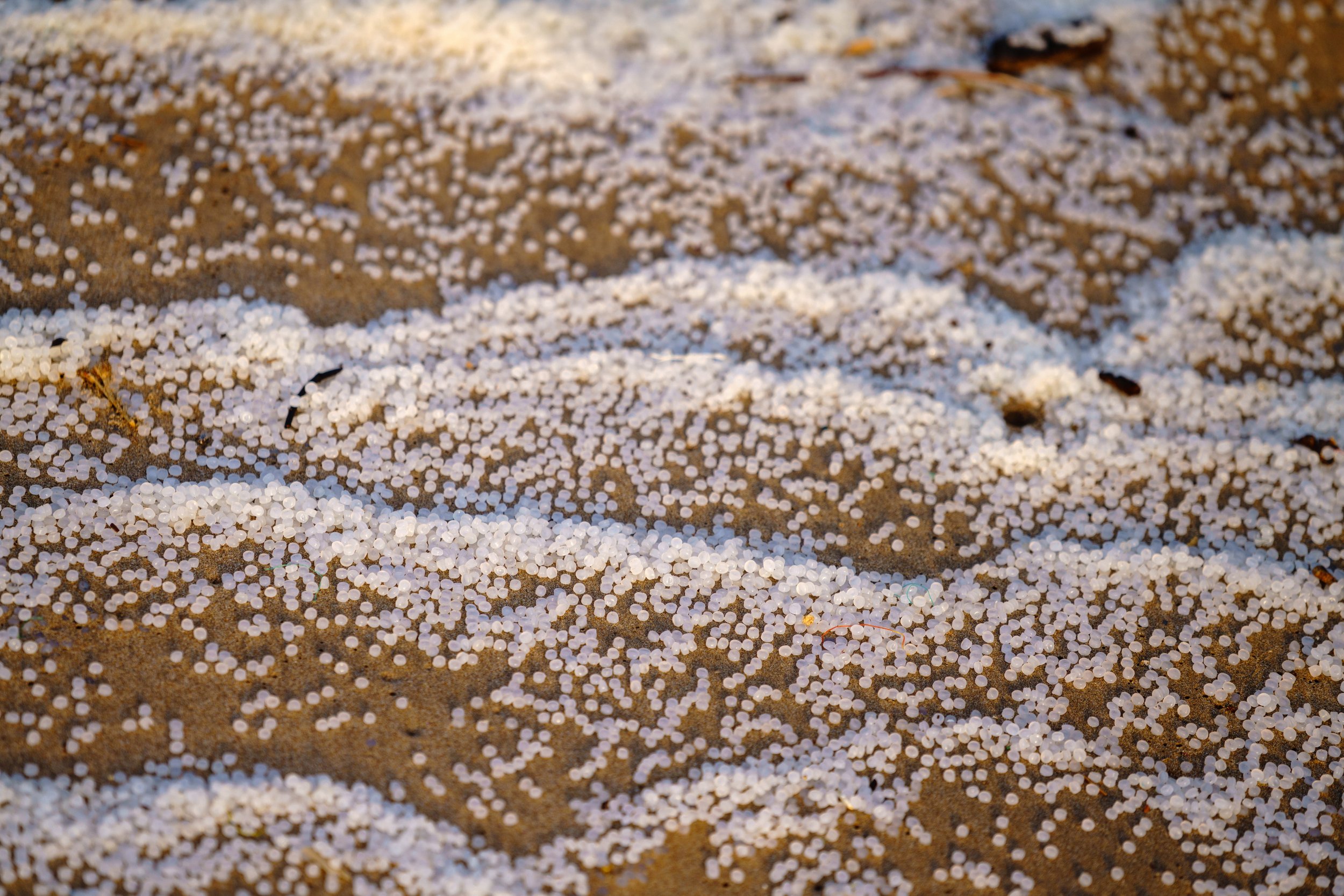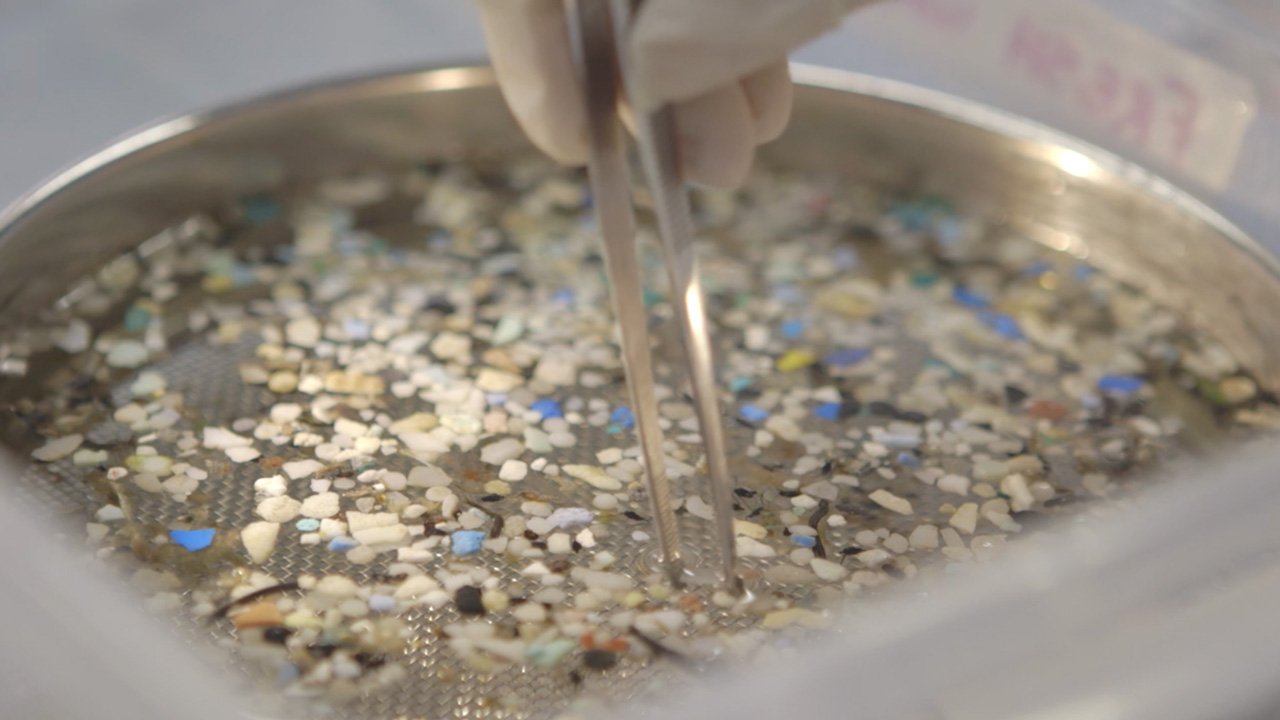ocean plastic sources: microbeads
Tiny plastic beads pollute the ocean and beaches the world over, they can often be found at the high-tide line, caught up in the seaweed and debris left there. They are about 0.3 mm in diameter, produced either by the plastic industry (and known as pellets or nurdles) or by the cosmetic industry. They are classed as primary microplastics as they are specifically manufactured to be smaller than 5 mm in diameter.
Globally an estimated 250,000 tonnes of nurdles enter the ocean every year. Nurdles are produced in their billions to be melted down and converted into plastic products and, because of their size, are often lost or spilled in the process, either in the production, handling or transport stage. Some are spilled directly into the ocean (as the 2021 sinking of the MV X-Press Pearl off the coast of Sri Lanka showed with an estimated 78 tonnes of nurdles released into the Indian Ocean) or they make their way there via drainage systems and groundwater. Easily ingested, nurdles have been found in marine life and seabirds all over the world.
As with all types of pollution, the best way to tackle the problem of nurdles is at their source, establishing best practice procedures to eliminate the improper disposal of any plastic materials in the production phase. Operation Clean Sweep (OCS) is leading the way in establishing such procedures.

Dimitry Anikin/Unsplash

Soeren Funk/Ocean Image Bank

Safia Shakil/Unsplash

The Ocean Cleanup
Microbead pollution from cosmetics is a relatively new phenomenon. Although the idea for the use of microbeads in the cosmetics industry evolved already in the 1960s it was only in the 1990s that commercial use of synthetic beads took off in personal hygiene and cosmetic products such as face washes, shampoos, shaving creams and toothpastes to cleanse and exfoliate. All but impossible to filter out of the wastewater, trillions of microbeads end up in the ocean each year. Natural materials with similar polishing or exfoliating functions like cocoa beans, pumice, sea salt or crushed almonds were replaced with tiny plastic beads of polyethylene (PE), polyethylene terephthalate (PET), polypropylene (PP), polymethylmethacrylate (PMMA) and nylon as the cosmetics industry quickly embraced what appeared to be a more efficient product and adapt its use without consideration of any possible detrimental effect on the environment. Similar to microfibres, once in the wastewater beads are almost impossible to remove due to their tiny size, and once again, the fact that the plastic does not decompose means that once they have entered the ocean they are there to stay. Again, as with microfibres, the chemicals already inherent in them (such as phthalates in nail varnish or hair spray) together with those they attract and absorb from the water effect both marine and eventually human life as they make their way up the marine food chain. One plastic microbead can be a million times more toxic than the water around it.
While microfibres can be caught before making their way into the ocean through the use of filters in washing machines or improved filtration systems in wastewater plants., microbeads tend to pass through these filtration systems leaving us with just one effective solution: avoid using them in the first place. Returning to natural alternatives such as those mentioned above or using beeswax, rice bran wax, jojoba waxes, starches derived from corn, tapioca and carnauba, seaweed, silica, or clay would be best.
There are currently just a handful of countries where legislation banning the use of microbeads exists: Canada, China France, Italy, New Zealand, Sweden, the United Kingdom and the United States of America have endorsed acts banning the use of microbeads in cosmetics products while bans in a number of other countries such as Brazil and India are due to come into force soon. In the meantime some companies in the cosmetics industry have stepped up in response to pressure from consumers, discontinuing the use of synthetic particles in their products. Regional groups of cosmetic manufacturers such as Cosmetics Europe have successfully implemented their own procedure with voluntary initiatives to phase out the use of beads. Microbeads have, for example, been removed from all rinse-off products under the European Union Ecolabel and 448 brands from 119 different manufacturers have so far promised to remove plastic microbeads from their products.
Spotlight on Fidra
Fidra is an environmental charity working to reduce plastic waste and chemical pollution in the ocean, on the beach and in the wider environment. According to their website Fidra works with the public, industry and governments to "deliver solutions which support sustainable societies and healthy ecosystems".
One of the main projects Fidra is working on is a campaign against nurdles, raising awareness of the problem with its annual Great Nurdle Hunt, asking everyone visiting a beach to count and report the number of nurdles that they find there, and adding this information to a map of nurdle pollution around the world. According to Fidra, simple steps can prevent spillage and leakage at all sites and facilities where nurdles are handled. They set out the necessary steps in their leaflet How do we tackle plastic pollution from global pellet loss? and in the paper Towards a regulatory approach to prevent plastic pellet loss in the EU co-authored with Fauna & Flora International and the Environmental Investigation Agency.
Spotlight on Beat the Microbead
Consumer pressure on the cosmetics industry is perhaps the most forceful tool of all in the fight against microbeads. The Beat the Microbead Campaign was launched in 2012 against rinse-off cosmetic products which contain visible microbeads. The fundamental idea behind the campaign is that consumers should know what contents their cosmetic products hold and be able to decide whether they wish to buy a product which includes microbeads. Their Beat the Microbead app enables consumers to do just that: users can scan the ingredients of cosmetic products in their shopping baskets to check for microplastics. At first the BTMB app set out to identify five ingredients known to be used as microbeads (polyethylene (PE), polyethylene terephthalate (PET), polypropylene (PP), polymethylmethacrylate (PMMA) and nylon). In cooperation with the European Chemical Agency the campaign has since been expanded to identify more than 500 microplastic ingredients which are widely used in cosmetics and personal care products. A further 100 "sceptical microplastic" ingredients are also under review for their impact on either human health or aquatic life. The app categorises the microplastics into four groups from red, through orange and green to zero. The categories are chosen according to criteria whether the plastics are persistent, bioaccumulative, and/or toxic, if they are readily biodegradable in all environments, and if they pose a risk for human health.
According to Beat the Microbead, recent research shows that many more types of plastics are being added to products than previously thought. They are also concerned by the fact that some companies are using 'bio-based' materials in place of microbeads, even though these do not break down in the water.
They have now developed a further step, turning the burden of proof around, and are asking producers to declare that their personal care products really are plastic-free. Only then are those products given the 'Zero Plastic Inside' certification, and included in the Zero category of the Beat the Microbead website and app.
